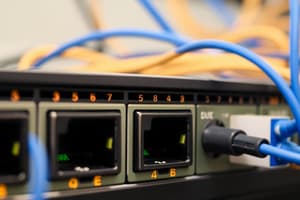Podcast
Questions and Answers
What is the primary purpose of network protocols like TCP and IP?
What is the primary purpose of network protocols like TCP and IP?
- To ensure interoperability and communication standards. (correct)
- To encrypt data for secure transmission.
- To prevent unauthorized access to network resources.
- To manage hardware configurations in a network.
In the encapsulation process, which layer is responsible for managing data segments?
In the encapsulation process, which layer is responsible for managing data segments?
- Transport Layer (correct)
- Application Layer
- Network Layer
- Data Link Layer
Which statement correctly distinguishes between an IP address and a MAC address?
Which statement correctly distinguishes between an IP address and a MAC address?
- IP addresses are permanent, while MAC addresses change frequently.
- IP addresses identify devices on a local network, while MAC addresses provide end-to-end delivery.
- IP addresses are used for routing between networks, while MAC addresses operate within a single local network. (correct)
- IP addresses are assigned manually, while MAC addresses are automatically generated.
What is the primary function of a default gateway in a remote network?
What is the primary function of a default gateway in a remote network?
Which of the following best describes the role of the OSI Model in networking?
Which of the following best describes the role of the OSI Model in networking?
What is a key characteristic of a Wide Area Network (WAN) compared to a Local Area Network (LAN)?
What is a key characteristic of a Wide Area Network (WAN) compared to a Local Area Network (LAN)?
Which of the following trends allows users to access network resources remotely?
Which of the following trends allows users to access network resources remotely?
Which term describes a network's ability to grow without performance loss?
Which term describes a network's ability to grow without performance loss?
What is the primary role of intermediary devices in a network?
What is the primary role of intermediary devices in a network?
Which type of network encompasses a large geographical area, such as cities or countries?
Which type of network encompasses a large geographical area, such as cities or countries?
What does 'Packet Switching' improve in a network?
What does 'Packet Switching' improve in a network?
Which security solution is particularly useful for large networks?
Which security solution is particularly useful for large networks?
How do protocols influence communication in a network?
How do protocols influence communication in a network?
Which characteristic of a reliable network prioritizes data types like video and voice?
Which characteristic of a reliable network prioritizes data types like video and voice?
What is a key function of the Network Interface Card (NIC)?
What is a key function of the Network Interface Card (NIC)?
Encapsulation in networking involves wrapping data in layers such as Frames, Packets, and Envelopes.
Encapsulation in networking involves wrapping data in layers such as Frames, Packets, and Envelopes.
The OSI model consists of seven distinct layers, while the TCP/IP model has only four.
The OSI model consists of seven distinct layers, while the TCP/IP model has only four.
An IP address is utilized exclusively for local network delivery, while a MAC address is necessary for end-to-end delivery.
An IP address is utilized exclusively for local network delivery, while a MAC address is necessary for end-to-end delivery.
In the de-encapsulation process, packets are transformed directly into application data.
In the de-encapsulation process, packets are transformed directly into application data.
The primary goal of network security is to enhance the speed of data transmission across networks.
The primary goal of network security is to enhance the speed of data transmission across networks.
A Wide Area Network (WAN) typically operates at a higher speed compared to a Local Area Network (LAN).
A Wide Area Network (WAN) typically operates at a higher speed compared to a Local Area Network (LAN).
BYOD (Bring Your Own Device) allows for flexibility in accessing the network, regardless of device ownership.
BYOD (Bring Your Own Device) allows for flexibility in accessing the network, regardless of device ownership.
A Local Area Network (LAN) connects multiple cities or countries.
A Local Area Network (LAN) connects multiple cities or countries.
The Internet is defined as a global collection of LANs and WANs that use various media types.
The Internet is defined as a global collection of LANs and WANs that use various media types.
Quality of Service (QoS) ensures data is delivered without any prioritization.
Quality of Service (QoS) ensures data is delivered without any prioritization.
In networking, external threats include breaches that are accidental.
In networking, external threats include breaches that are accidental.
A Network Interface Card (NIC) is used to connect a device to a network.
A Network Interface Card (NIC) is used to connect a device to a network.
Fault tolerance in a network refers to its ability to grow without performance loss.
Fault tolerance in a network refers to its ability to grow without performance loss.
Packet switching enhances fault tolerance by splitting traffic into packets.
Packet switching enhances fault tolerance by splitting traffic into packets.
BYOD stands for Bring Your Own Device, allowing employees to use personal devices for work.
BYOD stands for Bring Your Own Device, allowing employees to use personal devices for work.
Flashcards
Data Encapsulation
Data Encapsulation
Wrapping data in protocol layers (like envelopes) for network transmission.
Network Protocol
Network Protocol
A set of rules and standards for communication between devices on a network.
TCP/IP Model
TCP/IP Model
A set of communication protocols used for networking, structured around layers.
IP Address
IP Address
Signup and view all the flashcards
LAN (Local Area Network)
LAN (Local Area Network)
Signup and view all the flashcards
Network Security
Network Security
Signup and view all the flashcards
OSI Model
OSI Model
Signup and view all the flashcards
Network
Network
Signup and view all the flashcards
LAN
LAN
Signup and view all the flashcards
WAN
WAN
Signup and view all the flashcards
Network Components
Network Components
Signup and view all the flashcards
Network Architecture
Network Architecture
Signup and view all the flashcards
Packet Switching
Packet Switching
Signup and view all the flashcards
Communication Rules
Communication Rules
Signup and view all the flashcards
Network Types
Network Types
Signup and view all the flashcards
Internet
Internet
Signup and view all the flashcards
End Devices
End Devices
Signup and view all the flashcards
Intermediary Devices
Intermediary Devices
Signup and view all the flashcards
Fault Tolerance
Fault Tolerance
Signup and view all the flashcards
Scalability
Scalability
Signup and view all the flashcards
Quality of Service (QoS)
Quality of Service (QoS)
Signup and view all the flashcards
Security Threats
Security Threats
Signup and view all the flashcards
LAN vs. WAN
LAN vs. WAN
Signup and view all the flashcards
Network Security Goals
Network Security Goals
Signup and view all the flashcards
Emerging Network Trends
Emerging Network Trends
Signup and view all the flashcards
Study Notes
Introduction to Networks
- Networks enable global communication, collaboration, learning, and entertainment.
- Communication methods include texting, social media, online collaboration, blogging, and gaming.
Types of Networks
- LAN (Local Area Network): Covers a small area (home, office, campus), high speed, single administration.
- WAN (Wide Area Network): Connects LANs over large distances (cities, countries), slower speed, managed by multiple providers.
- Internet: A global network of interconnected LANs and WANs using copper, fiber optic, and wireless media.
Network Components
- End Devices: Devices that send or receive messages (computers, phones).
- Intermediary Devices: Manage data flow (routers, switches, firewalls).
- Media Types: Copper cables, fiber optics, wireless.
Network Architectures
- Fault Tolerance: Redundancy to prevent failures.
- Scalability: Ability to grow without performance loss.
- Quality of Service (QoS): Prioritization of data (video, voice).
- Security: Protecting the network and data (confidentiality, integrity, availability).
Networking Trends
- BYOD (Bring Your Own Device): Employees use personal devices for work.
- Cloud Computing: Storing and accessing data over the internet (public, private, hybrid clouds).
- Online Collaboration and Video Communication: Tools like Cisco WebEx.
- Smart Homes: Integrating technology into household appliances.
Security
- Threats: External (viruses, hacking, denial-of-service attacks) and internal (employee errors or malice).
- Solutions: Home networks use antivirus and firewalls; large networks use access control lists (ACLs), intrusion prevention systems (IPS), and virtual private networks (VPNs).
Key Terms
- Topology: Network layout (physical or logical).
- NIC (Network Interface Card): Connects devices to the network.
- Packet Switching: Dividing data into packets for improved fault tolerance.
Rules of Communication
- Communication requires a sender, receiver, and medium (channel).
- Protocols govern message formatting, timing, delivery, and acknowledgment.
- Data encapsulation packages data in layers (frame, packet, etc.).
Network Protocols and Standards
- Protocols ensure interoperability between devices using layers (TCP/IP, OSI).
- Examples of common protocols include HTTP (web communication), TCP (data management), and IP (addressing).
Data Encapsulation
- Data travels through layers when sent (encapsulation) and received (de-encapsulation).
- Application data is segmented, packetized, and framed before transmission.
Addressing
- IP Address: Identifies source and destination for end-to-end delivery.
- MAC Address: Facilitates data link delivery on the same network.
Network Access
- Local Access: Data link frames are sent directly between devices.
- Remote Access: Frames sent via a default gateway (router) to reach other networks.
Reference Models
- OSI Model: Seven layers (Application, Presentation, Session, Transport, Network, Data Link, Physical).
- TCP/IP Model: Four layers (Application, Transport, Internet, Network Access).
Network Security
- Goals: Confidentiality (authorized access only), integrity (preventing data alteration), availability (authorized access).
- Threats: External (viruses, attacks, theft) and internal (human errors, deliberate acts).
Network Types
- LAN: Small geographic area, high speed.
- WAN: Large geographic area, slower speed.
Emerging Trends
- BYOD (Bring Your Own Device): Flexibility in accessing the network.
- Cloud Computing: Remote access to resources (public, private, hybrid clouds).
- Online Collaboration and Video Communication: Tools for teamwork.
Internet Structure
- The Internet is a network of interconnected LANs and WANs via ISPs.
- Intranets and extranets are private networks for specific users.
Study Focus
- Understanding protocol layers (OSI vs. TCP/IP).
- The data encapsulation process.
- Security practices and threat mitigation.
- Network types and topologies.
- Emerging trends (BYOD, cloud, collaboration).
Studying That Suits You
Use AI to generate personalized quizzes and flashcards to suit your learning preferences.




